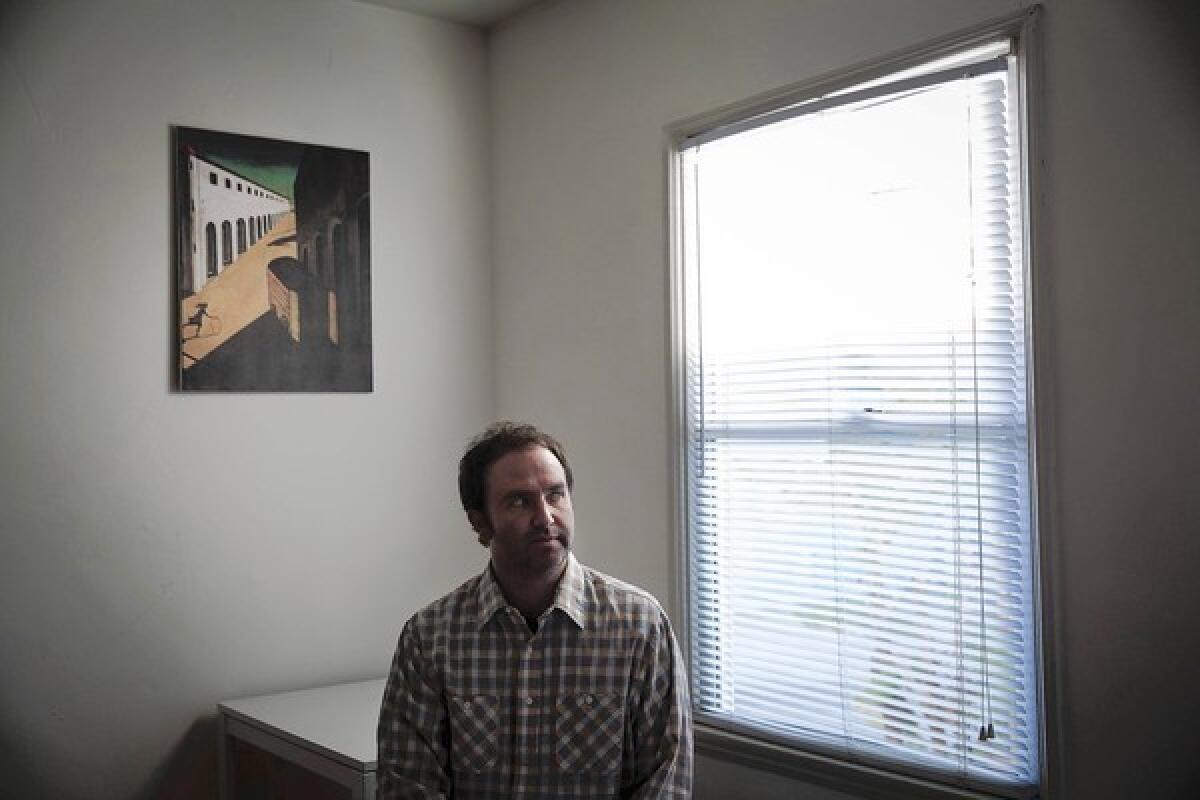Jim Gavin talks about the mix of fact and fiction in ‘Middle Men’

There’s a subtle arc to Jim Gavin’s first book, “Middle Men” (Simon & Schuster: 224 pp., $23). Gathering seven stories largely set in Southern California, it opens with a high school basketball player and ends with Marty Costello, a plumbing supply salesman who “averages 50,000 miles per year, vast territories, circles of latitude, Inglewood to Barstow, sailing across SoCal, all day every day.”
In between, we meet men of different ages, from Costello’s adult son Matt, also trying to make it in the plumbing supply business, to the 23-year-old protagonist of “Bermuda,” who follows a girl who doesn’t love him partway across the world.
“The collection moves from apprentice to journeyman to master,” Gavin explains, sitting in his Culver City apartment, sipping a beer in the thin light of a winter afternoon. “My hope is that the stories build on each other. I felt no compulsion to make that explicit, but it helped me see the structure of the book.”
At 36, Gavin is not unlike many of his characters: a former high school basketballer who did his own stint in plumbing sales. Born in Long Beach and raised in Orange, he is a product of the same communities, the same environments, with their tract houses and freeway overpasses.
“It’s to my advantage that I have a lousy imagination,” he jokes, cracking a loose grin amid a few days’ growth of beard. He’s a bit uneasy, not completely comfortable talking about his writing, but at the same time wholly genuine, wearing jeans and a shapeless T-shirt.
“I always liked writers,” he continues, “who can capture the texture of a place: which freeway, which drive-through restaurant. You many not know the exact building, but you know what it means to the character. I want to get that right.”
For Gavin, the roots of “Middle Men” go back nearly a decade, to a UCLA Extension workshop he took with novelist and short-story writer Lou Mathews in 2005.
To some extent, Gavin had already begun to zero in on writing as a way of living; as an undergraduate at Loyola Marymount, he majored in English — “kind of by default,” he acknowledges — and after graduation, he worked for a couple of years on the sports desk of the Orange County Register. It was in Mathews’ class, however, that he began to write fiction, and it was with Mathews’ encouragement that he applied for a Wallace Stegner Fellowship at Stanford in 2007.
“The big difference,” he says, “was that when I started class with Lou, it was the first time I had ever written about my life.” In part, he suggests, tongue not entirely in cheek, that he “wanted to write something that didn’t require research.” But more to the point, he started thinking about his experiences as material.
“The plumbing stuff,” he recalls, “I would tell people about it at the pub, and they’d say, ‘Why don’t you write about that?’ I began to see that I was stuck with myself, that these were the stories I had. I’ll probably branch out in the future, but I needed to write this first.”
The autobiographical aspects of “Middle Men” may prompt the question of why Gavin chose to work in fiction, but in his mind there was never any doubt.
“Fiction is the thing I love most,” he says, “and even if it’s autobiographical, I can shape it in a way, construct the story to get at something I couldn’t do in nonfiction, a different kind of truth.”
As an example, he cites “Play the Man” — the high school basketball story — which blurs the line between memory and imagination, between what happened and what never did. The narrator, Gavin acknowledges, is him, a kid who dreams of stardom even as he knows that dream will not come true. And yet, his foil, a teammate named Tully, is a creation, a character who “tells the truth and has no illusions; he sees exactly where he’s going all the time.”
Tully is often unsympathetic, even antagonistic, but his presence sets up an essential tension, a resistance for the narrator to push against. “Every story,” Gavin notes, “has one thing that’s invented, and it changes everything. That, for me, is the joy.”
There is, of course, another joy to “Middle Men,” which is its portrait of Southern California as neither glamorous nor mythic but instead defined by what D.J. Waldie has called “sacred ordinariness.” This is both the most obvious thing in the world and utterly refreshing, given all the imposed meanings, the clichés and stereotypes, that make it so difficult to see this place for what it is.
Gavin’s Los Angeles stands blessedly outside Hollywood; the one story with an industry angle, “Elephant Doors,” focuses on a production assistant (a job Gavin also had). Otherwise, the characters here are adrift, wrestling with loss (the death of a wife or mother), unsure of where they’re going or who they are.
In that regard, Gavin says, the stories represent “the culmination of their screw-ups” — yet if that sounds dismal, or even tragic, the key to the book is their ability to persevere.
As if to make the point explicit, Gavin remembers high school, when he knew an older boy who one day went into the alley behind the K-Mart where he worked and shot himself. Gavin too worked at K-Mart (although a different one), and he and the dead boy looked enough alike to be mistaken for relatives.
The difference, Gavin has come to realize, is that “I was too dumb; I retained some sense of hope” — which is what marks his characters, as well. From that high school basketball player to Marty Costello, widowed, still driving the freeways, meaning accrues in the smallest moments, which is true for every one.
“All my characters,” Gavin says, “are waiting for something they think will save them, but it never arrives. None of them get what they want. And yet, they do end up with some sort of understanding. Their delusions save them. The same was true of me.”
More to Read
Sign up for our Book Club newsletter
Get the latest news, events and more from the Los Angeles Times Book Club, and help us get L.A. reading and talking.
You may occasionally receive promotional content from the Los Angeles Times.








